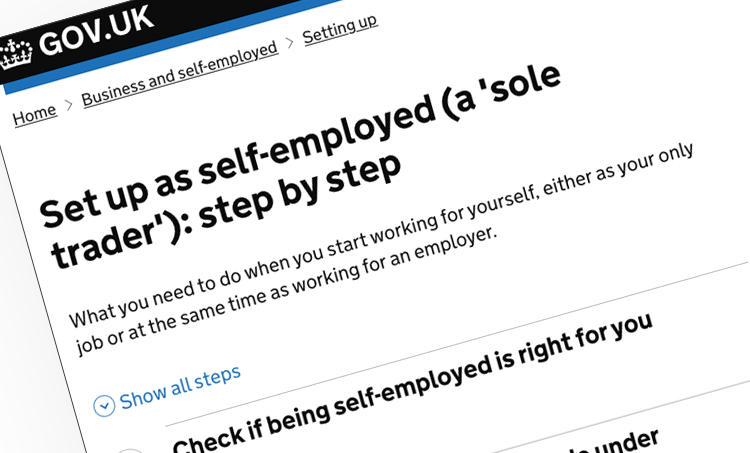Last Updated on: 22nd November 2023, 01:35 pm
If you are planning to work for yourself in the UK, you will need to register as self-employed with HM Revenue and Customs (HMRC). By registering, you will be able to pay taxes and National Insurance contributions on your earnings. This guide will walk you through the process of registering as self-employed in the UK, including the information you need to provide and the deadlines you need to meet.
Firstly, you need to determine whether you are self-employed according to HMRC’s definition. You are considered self-employed if you run your own business or work for yourself and take responsibility for its success or failure. If you are unsure whether you are self-employed, you can use HMRC’s employment status checker tool to find out.
Once you have confirmed that you are self-employed, you can register with HMRC online or by phone. You will need to provide information about your business, including the date you started trading and your contact details. HMRC will then send you a Unique Taxpayer Reference (UTR) and activate your Self Assessment online account. From this point, you will need to file a tax return every year and pay the tax you owe by the deadlines set by HMRC.
Determine If You Are Self-Employed
What it means to be self-employed
If you are self-employed, it means that you work for yourself and run your own business. You are responsible for finding work, negotiating contracts, and managing your finances. You are not an employee, so you do not have the same rights and benefits as an employee. You are responsible for paying your own taxes and National Insurance contributions.
How to determine your employment status
There are several factors that determine whether you are self-employed or an employee. These include:
- The level of control you have over your work
- Whether you can subcontract work to others
- Whether you provide your own equipment and tools
- Whether you take on financial risk
- Whether you are required to work set hours
- Whether you receive holiday pay, sick pay, and other benefits
If you are unsure whether you are self-employed or an employee, you can use the HM Revenue and Customs (HMRC) employment status checker to help you determine your employment status. This tool will ask you a series of questions about your work to help you determine whether you are self-employed or an employee.
It is important to determine your employment status correctly, as it will affect your tax and National Insurance contributions. If you are self-employed, you will need to register with HMRC and file a self-assessment tax return each year. You may also need to pay VAT if your business turnover exceeds a certain threshold.
Registering as self-employed
If you’re working for yourself, you may need to register as self-employed with HM Revenue & Customs (HMRC). This section will guide you through the process of registering as self-employed in the UK.
When to register
You need to register as self-employed with HMRC as soon as you start trading. This means that you need to register if you:
- sell goods or services
- earn more than £1,000 from self-employment in a tax year
If you’re not sure whether you need to register, you can use the HMRC’s online tool to check your employment status.
How to register
The easiest way to register as self-employed is to use the HMRC’s online registration service. To register online, you’ll need:
- Your National Insurance number
- Your contact details
- Your business name (if you have one)
- Your business address (if you have one)
- Your business start date
- Your business type
- Your business activity
Once you’ve gathered all the necessary information, you can register online by visiting the HMRC’s website and following the step-by-step instructions. You’ll need to create a Government Gateway account if you don’t already have one.
If you prefer, you can also register by phone or by post. To register by phone, call the HMRC self-employment helpline on 0300 200 3500. To register by post, you’ll need to download and fill in the CWF1 form from the HMRC website and send it to the address on the form.
Once you’ve registered as self-employed, you’ll need to keep accurate records of your business income and expenses and complete a self-assessment tax return each year.
National Insurance Contributions
What are National Insurance Contributions?
When you’re self-employed in the UK, you are required to make National Insurance (NI) contributions. These contributions go towards your entitlement to state benefits such as the State Pension, Maternity Allowance, and Bereavement Allowance. There are two types of NI contributions that you may need to pay: Class 2 and Class 4. Class 2 contributions are a fixed weekly amount of £3.45 and are payable if your profits are over £6,515 per year. You may be exempt from paying Class 2 contributions if you earn less than this amount, or if you are eligible for certain benefits. Class 4 contributions are based on your profits and are payable if your profits are over £9,568 per year. The rate of Class 4 contributions is 9% on profits between £9,568 and £50,270, and 2% on profits over £50,270.
How to pay National Insurance Contributions
Most self-employed individuals pay their NI contributions through their Self Assessment tax return. You will need to register for Self Assessment with HM Revenue and Customs (HMRC) if you haven’t already done so. Once registered, you will need to complete a tax return each year and include details of your profits and any NI contributions due. You can pay your NI contributions in a number of ways, including:
- Direct Debit
- Online or telephone banking
- At your bank or building society
- By post using a payslip from HMRC
It’s important to keep up to date with your NI contributions to ensure that you are entitled to the benefits you need. If you have any questions or concerns about your NI contributions, you can contact HMRC for advice and guidance. Remember, paying your NI contributions is an important part of being self-employed in the UK. By keeping up to date with your contributions, you can ensure that you are eligible for state benefits and have peace of mind knowing that you are contributing to the wider community.
Tax and Accounting
As a self-employed individual in the UK, it is important to understand your tax obligations and keep accurate records of your income and expenses. In this section, we will cover the basics of tax and accounting for self-employed individuals.
Understanding Tax Obligations
When you are self-employed, you are responsible for paying your own taxes. You will need to register for Self Assessment with HM Revenue and Customs (HMRC) and file a tax return each year. You will also need to pay National Insurance contributions.
The amount of tax you will need to pay depends on your income. You will need to pay income tax on your profits, which is calculated by subtracting your allowable expenses from your income. The current income tax rates for self-employed individuals in the UK are:
| Income Tax Band | Income Tax Rate |
|---|---|
| Up to £12,570 | 0% |
| £12,571 to £50,270 | 20% |
| £50,271 to £150,000 | 40% |
| Over £150,000 | 45% |
It is important to keep accurate records of your income and expenses so that you can claim all allowable deductions and pay the correct amount of tax. You should keep records of all invoices, receipts, and bank statements.
Keeping Accurate Records
Keeping accurate records is essential for managing your business finances and complying with tax regulations. You should keep records of:
- All sales and income
- All business expenses
- Business assets
- Mileage if you use a vehicle for business purposes
You can keep records on paper or using accounting software. There are many accounting software options available, such as QuickBooks, Xero, and FreeAgent.
You should also keep track of your National Insurance contributions. You will need to pay Class 2 National Insurance contributions if your profits are £6,515 or more per year. If your profits are over £9,568 per year, you will also need to pay Class 4 National Insurance contributions.
By understanding your tax obligations and keeping accurate records, you can ensure that you are paying the correct amount of tax and avoiding any penalties or fines from HMRC.
Once you are self employed you have the legal duty to file a tax return every following year before the 31st of January. You can read our guide on how to do your self employed tax return or you can download the SA103F form here, you can also do this online via your self assessment login via .gov.uk or via your accountant if you have one.





